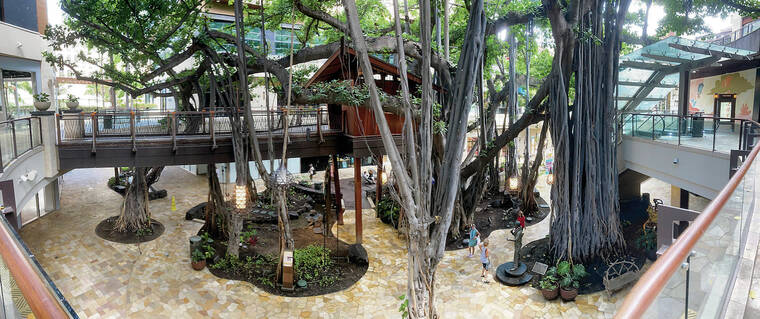Visitors to the International Market Place now have the option to experience a free audio story tour that launched earlier this month on the TravelStorys application.
The audio story spans about an hour and features 20 geotagged locations throughout the shopping center. It describes the history and culture of an area of Waikiki that was once known as Apuakehau.
“If you walk through the center, you’ll see that there are plaques throughout the center that tell the historical anecdotes about the area,” said Malia Zannoni, the IMP’s marketing and sponsorship director. “But we wanted to go a step further and offer something that was a little bit more immersive.”
Incorporating culture and historical significance into the design of the redeveloped marketplace has been a priority since its makeover in 2016, Zannoni said. Since the IMP’s redevelopment, marketplace leaders have worked with Hawaiian strategy studio DTL Hawaii to create and incorporate culturally significant features into its design, she said.
Part of those features has included informational plaques installed throughout the shopping center and erecting statues of those whose history is tied to the location, such as Don Ho and Queen Emma. Even certain architectural features have cultural significance, such as the constellation featured on the floor of the ground-floor stage, which was used by Hawaiian navigators to guide them on their voyages, said DTL Hawaii founder and President Malia Ka‘aihue.
“It represents Waiakeakua Falls,” Zannoni said. “That waterfall falls into Manoa Valley and then flows into the stream that once flowed through the area called Apuekehau.”
Incorporating a cultural tour through the marketplace had always been a floating idea, Zannoni said. But the production of the audio tour only began once COVID-19 began slowing down other aspects of the shopping center and gave them time to fully focus on the project.
The roughly one-hour audio tour starts at the mauka entrance of the shopping center and guides the listener to 20 locations throughout the IMP. It can be experienced in English, Hawaiian or Japanese, and features soundbites of crashing waves, Hawaiian chants, songs and narration done by Napali Souza, who curated the audio story.
Listeners will learn about the history of Apuakehau — which is the traditional Hawaiian name of the area where the IMP sits — and Queen Emma, who bequeathed the IMP property in trust to support the hospital she co-founded, The Queen’s Medical Center.
The audio story covers a range of topics, and many of IMP’s visitors, both local residents and visitors alike, might find themselves learning something new.
“People associate Waikiki with Diamond Head and with shave ice and surfing,” Ka‘aihue said. “What makes this different is the rich content that’s in this audio tour that people wouldn’t otherwise associate with Waikiki.”
In the process of putting together the audio story, Ka‘aihue said that bringing the featured songs and chants to life were a particularly important feature.
“Hawaiians never traditionally had a written culture or language. … Many of our stories are embedded in the songs and the chants about these places,” Ka‘aihue said. “So it was really important that we could authentically share voices and elements that would really bring people into the journey with you, so that it was less like hearing an audio book and more like being on a journey.”
The Hawaiian audio option was translated by Aha Punana Leo, an organization dedicated to the perpetuation of olelo Hawaii, Zannoni said. Meanwhile, the information incorporated into the story was based on significant historical and cultural research that DTL had gathered since the beginning of their relationship with the International Market Place, as well as additional information that was researched once the audio story’s production began.
Zannoni, who has always found herself interested in the history of the places she visits, hopes that others will get to experience the area’s rich history through the audio story. While some believe that its redevelopment was a loss of history and culture, she believes that IMP is representing the area’s story in a much greater way.
“The new center, it looks different. … It doesn’t look like the Polynesian Village that it was before,” she said. “People sometimes confuse things like the old tiki statues with Hawaiian culture, but really, it’s the storytelling that’s important to know what was really there.”
———
Linsey Dower covers ethnic and cultural affairs and is a corps member of Report for America, a national service organization that places journalists in local newsrooms to report on undercovered issues and communities.




